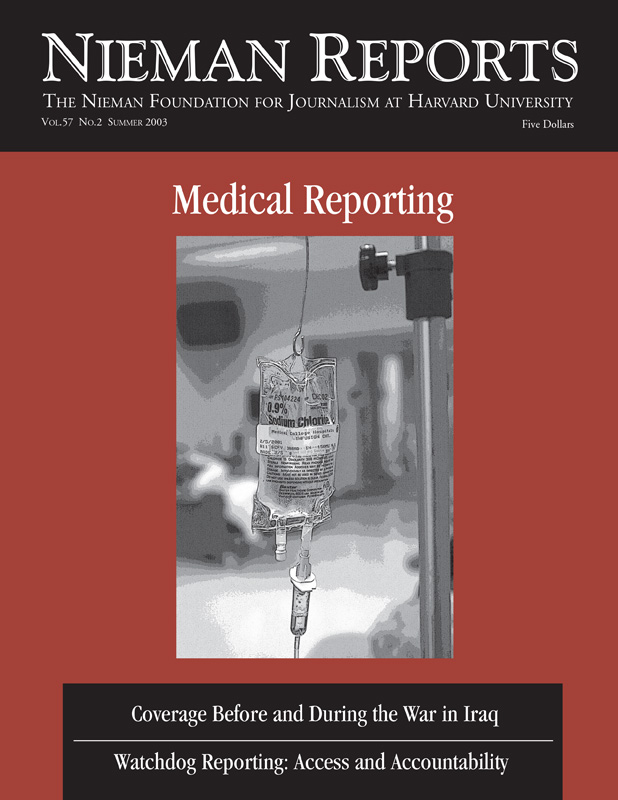“We don’t show the faces of the dead. We don’t show the faces of the wounded, especially in this time of satellite television. We don’t want to be in a position where we on television are notifying the next of kin. But I think you do show bodies, shooting them in as responsible a fashion as possible. In time of war we don’t want to soft-pedal what is going on here. That would be contrary to the whole purpose of our being here. One thing you cannot do is leave people with the impression that war is not a terrible thing.”
—Ted Koppel, ABC News “Nightline” anchor and an embedded correspondent during the war, quoted in the March 28, 2003 Washington Post story, “The News Veteran ‘Nightline’ Anchor Ted Koppel Had to See for Himself the Shape of a Conflict Drawn in Sand,” by Howard Kurtz.
“Television viewers love to see war, they love the bang-bang. But show them what it really is about, and the switchboard lights up. (That’s what happened when Rodgers showed an Iraqi soldier’s body next to a burnt-out armored personnel carrier during live coverage on the road to Baghdad.) … It’s dishonest not to show that. You ought to show even more than taste allows so no one has any illusions how terrible carnage and war are.”
—Walter Rodgers, CNN correspondent traveling with the Army’s 7th Cavalry, quoted in an April 17, 2003 Newsday story, “CNN’s Rodgers Faults Queasy Networks,” by Harry Berkowitz.
“The American TV carries us live when there is bombing in the skies of Baghdad, the shock and awe. But when it comes to the casualties from the Iraqi or the American side, they don’t want to see it. If we didn’t show them [these graphic images], that would not be realistic journalism.”
—Hafez al-Mirazi, Washington bureau chief for Al Jazeera, quoted in a March 26, 2003 Boston Globe article, “Differing TV Images Feed Arab, U.S. Views,” by John Donnelly and Anne Bernard.
“For Arab News, the decision to post the photographs, which show the interrogation of American military men and women and the bodies of what appear to be dead soldiers, was a basic question of journalistic objectivity. The American media were hiding a truth of the war, and Arab News felt obliged to fill in a glaring gap. For American news organizations, which have refrained from showing all but glimpses of the footage, it was far from simple. It was a matter of taste, ethics, professional standards, and responsibility to a complex web of constituents: viewers, families of the soldiers, the government, and news organizations’ often vaguely defined sense of journalistic mission and responsibility.
“At issue, however, are several questions central to reporting and consuming news in this era of 24-hour television coverage and the burgeoning independent news media on the World Wide Web: Are images facts or illustrations? If a fact is ugly, should it be kept at a distance from readers and viewers? And what do news organizations do with the simple fact that there is both an eager appetite for, and a sincere disgust with, graphic images?”
—Philip Kennicott, in his March 25, 2003 Washington Post story, “The Illustrated Horror of Conflict: Images Convey Facts That Are Hard to Face.”
“Certainly the reach of The Hartford Courant is far less than that of The New York Times and The Washington Post. So The Courant weighs the considerations of publishing such images a little differently. But I fear that with the news media so snug with the troops in Iraq and Kuwait, recoiling from newsworthy images only gives skeptics here and abroad the opportunity to ask what else the U.S. media are willing to withhold.”
—Karen Hunter, The Hartford Courant’s reader representative, quoted on ABCnews.com on April 1, 2003.



